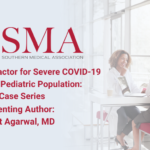Abstract | November 13, 2020
Obesity a Risk Factor for Severe COVID-19 Morbidity in Pediatric Population: A Case Series
Learning Objectives
- Given the limited availability of data about the spectrum of the COVID-19 in pediatric population, it is paramount to promptly identify the risk factors which puts patients at higher risk for development of severe disease.
- Early recognition of the high risk factors will help healthcare providers to anticipate the level of care needed by a patient and will benefit the healthcare system at large with early and proper isolation of the patient, judicious use of resources and personal protection measures taken by healthcare workers.
- Emphasis on early recognition and general awareness of clinical and laboratory features of MISC development in pediatric patients infected with COVID-19.
Introduction: With the emergence of COVID-19 pandemic, many studies have been published to determine the spectrum of illness, risk factors, prevention, and treatment strategies. Due to relatively fewer pediatric cases as compared to adults, there is a paucity of clinical data available to fully understand the risk factors and disease course in the pediatric population. Our understanding is evolving with limited data showing an increased risk of severe or critical disease in children aged <year and those with underlying conditions, such as chronic lung disease (including asthma), cardiovascular disease, and immunosuppression according to the CDC. Recognition of emerging risk factors for morbidity and mortality is now paramount, in order to anticipate and provide appropriate clinical care specific to the pediatric population. To date, obesity has been suggested but not well described as a risk factor for severe COVID-19 disease in children.
Case presentation: This case series outlines two adolescent female patients requiring pediatric ICU level care, who presented with severe acute respiratory syndrome from COVID-19 with similar initial presentations and the shared risk factor of obesity.
Case 1: A 16-year-old female with BMI 47.7kg/m2 presented with 5 days of fever, vomiting, diarrhea, cough, and shortness of breath (SOB) that developed after she attended a graduation party. On examination, she was alert but in moderate distress with shallow breaths, clear lung field, mild abdominal tenderness, and oxygen desaturations to 80% with activity. She was also found to have cracked lips and purple discoloration of her toes. She tested positive for COVID-19 with evidence of infiltrates and bilateral pneumonia on chest X-ray.
Initially, she was placed on 3L oxygen support via nasal cannula. Over a period of 24 hours, she developed progressively worsening hypoxia and respiratory distress, requiring escalation of oxygen support to Vapotherm 40L with 100% FiO2 and transfer to the PICU. Due to her continued respiratory deterioration, support was escalated to BIPAP for the next 24 hours. She was then intubated due to persistent hypoxia and started on ventilatory support with the addition of nitric oxide. She was extubated after 9 days and gradually improved.
During her hospitalization, she also had elevated ESR/CRP, elevated transaminases, hypoalbuminemia, thrombocytopenia, leukopenia, and elevated fibrinogen, D-dimer, creatinine kinase and lactate dehydrogenase concerning for multi-system inflammatory syndrome (MIS-C). She was treated with remdesivir, convalescent COVID-19 antibody serum, dexamethasone, IVIG, and prophylactic lovenox for anticoagulation. She was discharged after a total of 21 days of hospitalization.
Case 2: A15-year-old female with BMI 43.7 kg/m2, poorly controlled asthma and untreated hypothyroidism presented with 5 days of fever, congestion, cough, SOB, and headache. On examination, she was alert with minimal acute distress, had decreased breath sounds in lower lobes and crackles over the posterior lung fields (postural), with oxygen desaturations to 80% with activity. She tested positive for COVID-19 without any evidence of airspace disease on CXR. Initially she was placed on 2L oxygen support via nasal cannula, however, she rapidly deteriorated over a course of 8 hours with increasing oxygen requirements and was transitioned to Vapotherm 16L with 50% FiO2. She was transferred to the PICU. She received albuterol, dexamethasone, and prophylactic lovenox for anticoagulation. Due to persistent hypoxia, her respiratory support was increased to Vapotherm 35L with 70% FiO2 over the course of 48 hours with clinical improvement in hypoxia and respiratory status. Her support was weaned to room air over the next 48 hours, and then she was observed for 24 hours off of any supplemental oxygen before discharging home. Fortunately, this patient responded well to high flow oxygen alone and did not require ventilatory support. Her total length of hospitalization was 7 days. This patient was also assessed for the possibility of concurrent MIS-C but her lab work up, historical or clinical manifestation ruled out the diagnosis.
Upon completion of this lecture learners should be better prepared to identify at high risk pediatric patients based on their history and presentation of patients positive for COVID-19. They should be able to be aware of the needs of these patients in advance so that quick and adequate measures can be taken to help escalate care.They should also be prepared for protecting themselves and other healthcare workers from this life-threatening viral illness.

